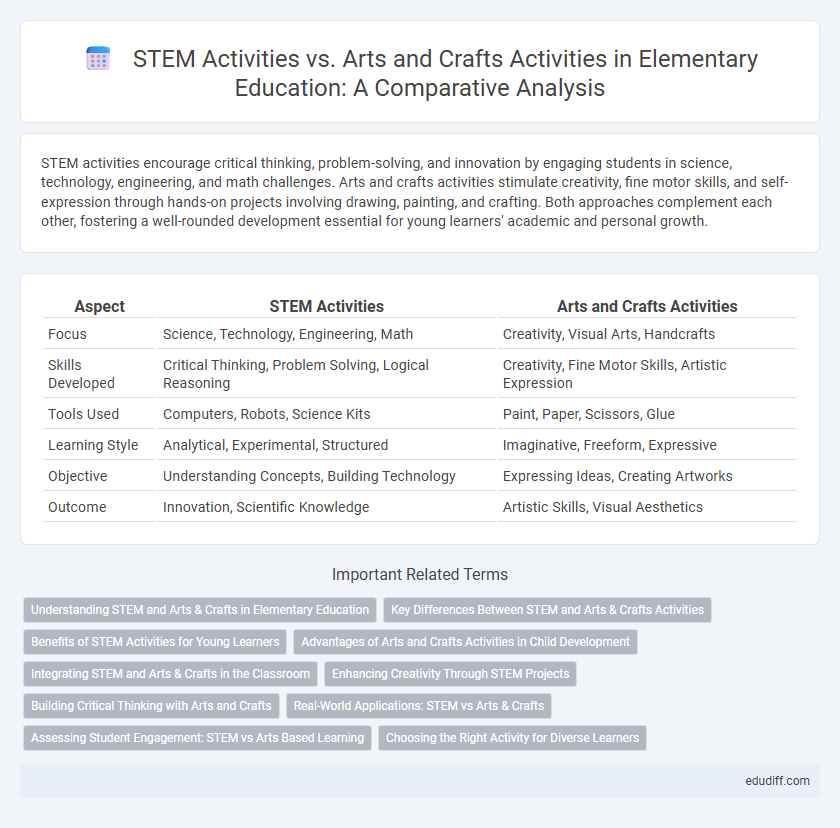STEM activities encourage critical thinking, problem-solving, and innovation by engaging students in science, technology, engineering, and math challenges. Arts and crafts activities stimulate creativity, fine motor skills, and self-expression through hands-on projects involving drawing, painting, and crafting. Both approaches complement each other, fostering a well-rounded development essential for young learners' academic and personal growth.
Table of Comparison
| Aspect | STEM Activities | Arts and Crafts Activities |
|---|---|---|
| Focus | Science, Technology, Engineering, Math | Creativity, Visual Arts, Handcrafts |
| Skills Developed | Critical Thinking, Problem Solving, Logical Reasoning | Creativity, Fine Motor Skills, Artistic Expression |
| Tools Used | Computers, Robots, Science Kits | Paint, Paper, Scissors, Glue |
| Learning Style | Analytical, Experimental, Structured | Imaginative, Freeform, Expressive |
| Objective | Understanding Concepts, Building Technology | Expressing Ideas, Creating Artworks |
| Outcome | Innovation, Scientific Knowledge | Artistic Skills, Visual Aesthetics |
Understanding STEM and Arts & Crafts in Elementary Education
STEM activities in elementary education emphasize critical thinking, problem-solving, and hands-on experiments related to science, technology, engineering, and mathematics. Arts and crafts activities foster creativity, fine motor skills, and self-expression through drawing, painting, and crafting materials. Integrating STEM and arts encourages a balanced development of analytical and creative skills essential for young learners' holistic growth.
Key Differences Between STEM and Arts & Crafts Activities
STEM activities emphasize science, technology, engineering, and mathematics through problem-solving and critical thinking, fostering skills such as coding, robotics, and experiments. Arts and crafts activities focus on creativity, self-expression, and fine motor skills by engaging with materials like paint, clay, and paper to create visual and tactile artwork. Both approaches develop important cognitive and motor skills but differ in objectives, with STEM targeting analytical reasoning and arts and crafts nurturing imaginative and artistic abilities.
Benefits of STEM Activities for Young Learners
STEM activities enhance critical thinking, problem-solving, and creativity by engaging young learners in science, technology, engineering, and math concepts through hands-on experiments and challenges. These activities promote logical reasoning and collaboration, preparing children for future academic success and careers in high-demand fields. Integrating STEM at an elementary level fosters curiosity and builds foundational skills essential for innovation and technological literacy.
Advantages of Arts and Crafts Activities in Child Development
Arts and crafts activities enhance fine motor skills and hand-eye coordination in elementary children, fostering creativity and self-expression. These activities support emotional development by providing a calming outlet for stress and boosting confidence through tangible achievements. Engaging in arts and crafts also improves problem-solving abilities and encourages imaginative thinking crucial for overall cognitive growth.
Integrating STEM and Arts & Crafts in the Classroom
Integrating STEM and Arts & Crafts activities in the elementary classroom enhances creativity and critical thinking by blending science, technology, engineering, and math concepts with hands-on artistic expression. This approach fosters interdisciplinary learning, encouraging students to apply problem-solving skills alongside creative design, improving engagement and retention. Projects like building simple machines and decorating them or creating artwork based on geometric patterns exemplify effective STEM and arts integration.
Enhancing Creativity Through STEM Projects
STEM activities enhance creativity by encouraging problem-solving, critical thinking, and hands-on experimentation, which build innovative skills in students. These projects integrate science, technology, engineering, and mathematics to stimulate curiosity and promote real-world applications. Arts and crafts activities nurture artistic expression and fine motor skills, but STEM projects specifically drive creative solutions through logical analysis and design challenges.
Building Critical Thinking with Arts and Crafts
Arts and crafts activities enhance critical thinking by encouraging problem-solving, creativity, and decision-making in elementary students. Unlike some STEM activities that focus on specific technical skills, arts and crafts allow children to explore open-ended projects that develop cognitive flexibility and innovative thinking. Engaging in hands-on artistic tasks strengthens visual-spatial reasoning and promotes independent thought essential for critical analysis.
Real-World Applications: STEM vs Arts & Crafts
STEM activities develop critical thinking and problem-solving skills by engaging students in real-world applications such as building simple machines, coding, and conducting experiments. Arts and crafts activities boost creativity and fine motor skills through hands-on projects like painting, sculpting, and designing, offering tangible artistic expression without a direct focus on scientific principles. Both approaches support different aspects of learning, with STEM emphasizing analytical skills for technology and engineering, while arts and crafts encourage innovation and emotional expression.
Assessing Student Engagement: STEM vs Arts Based Learning
Assessing student engagement in STEM activities reveals increased problem-solving and critical thinking skills, as students actively participate in hands-on experiments and technology use. Arts and crafts activities promote creativity, fine motor skills, and emotional expression, encouraging students to explore self-expression through various mediums. Comparing both, STEM activities often lead to higher cognitive engagement, while arts-based learning enhances emotional and imaginative involvement in elementary students.
Choosing the Right Activity for Diverse Learners
STEM activities develop critical thinking and problem-solving skills, engaging students through hands-on experiments in science, technology, engineering, and math. Arts and crafts activities foster creativity, fine motor skills, and self-expression, offering diverse learners a tactile and visual approach to learning. Selecting the right activity depends on individual student interests, learning styles, and developmental goals to create an inclusive and balanced curriculum.
STEM Activities vs Arts and Crafts Activities Infographic

 edudiff.com
edudiff.com